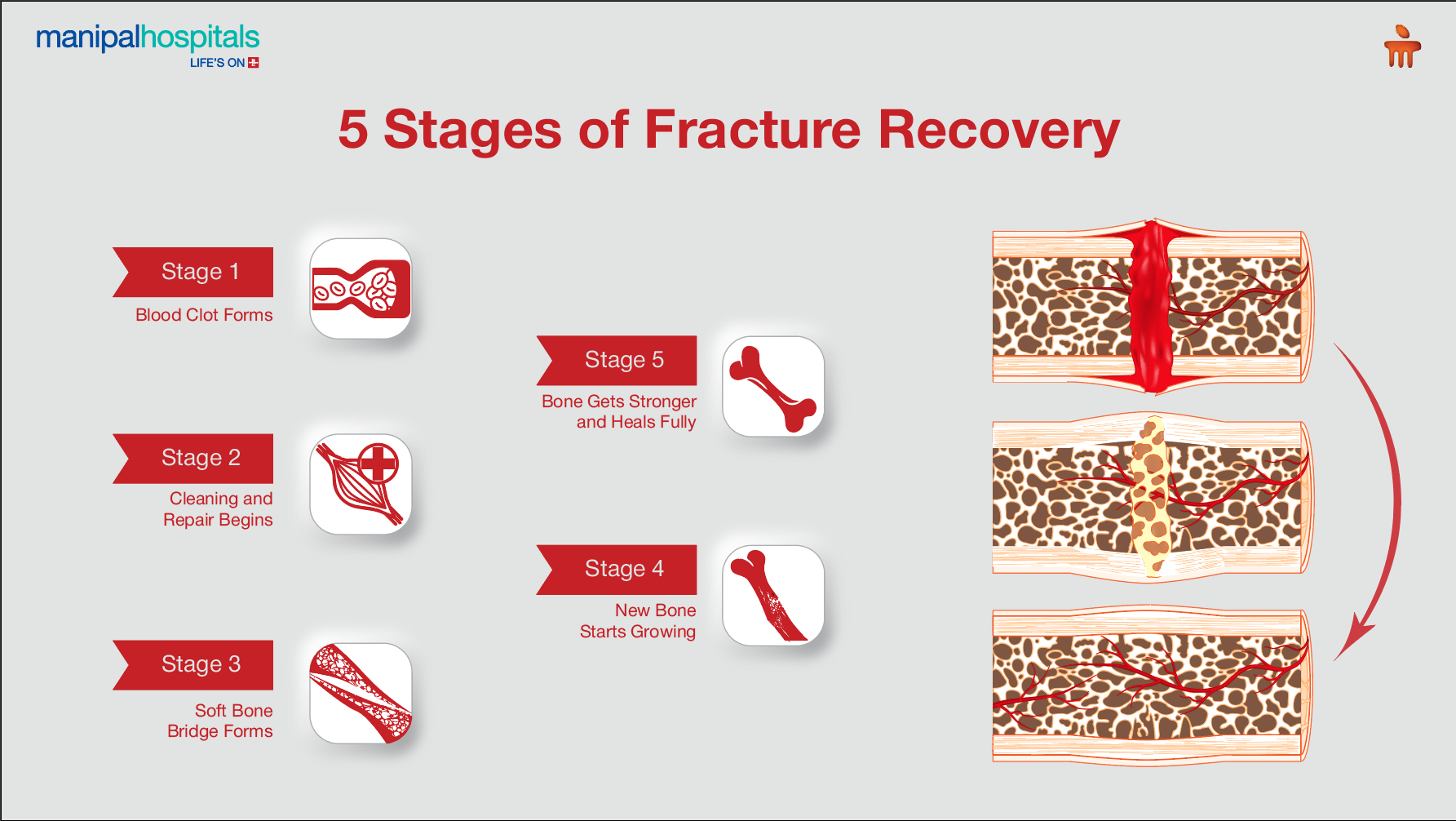
A broken bone is more than just a physical injury—it can disrupt your daily life, affect your mobility, and raise several questions about recovery. One of the most common questions patients ask is: “How long does it take for a broken bone to heal?”
The answer lies in understanding the stages of fracture healing—a complex biological process that your body undertakes to repair and restore the strength of a broken bone. From initial inflammation to the final reshaping of bone, this journey spans several weeks and involves multiple stages. In this blog, we explore the bone healing process, the typical bone healing timeline in weeks, and what you can do to support your recovery effectively.
Synopsis
Why Understanding the Healing Process Matters?
Knowing what happens inside your body after a fracture can:
-
Help manage expectations during recovery
-
Encourage you to follow medical advice diligently
-
Reduce the risk of complications or delayed healing
The healing process involves five well-recognised phases. While each person's recovery journey is unique, these stages offer a reliable roadmap of what to expect.
The 5 Stages of Fracture Healing

Let’s walk through the 5 stages of fracture healing, step-by-step.
1. Hematoma Formation (Immediately After the Fracture – Day 1 to 7)
The first response to a fracture is internal bleeding around the broken bone. Blood vessels are ruptured, leading to the formation of a hematoma (a localised blood clot) at the fracture site. This marks the start of the bone healing process.
During this stage:
-
The affected area becomes swollen and tender.
-
The hematoma helps protect the bone ends.
-
Inflammatory signals are released to recruit healing cells.
Though it may not look like healing on the outside, this phase lays the groundwork for what’s to come.
2. Inflammatory Stage and Cellular Cleanup (Week 1–2)
As the hematoma stabilises, the body initiates an inflammatory response. White blood cells and macrophages arrive to clear out dead cells, damaged tissue, and potential pathogens. This cleanup is essential for the next stages of tissue repair.
This stage is especially sensitive to factors affecting fracture healing, such as:
-
Poor blood supply
-
Smoking or alcohol use
-
Diabetes or immunocompromised conditions
If the inflammatory phase is disrupted, the rest of the healing process may be delayed or incomplete.
3. Soft Callus Formation (Week 2–3)
Within the second and third weeks, the body begins to form a soft bridge of tissue across the fracture site. Fibroblasts and chondroblasts start producing collagen and cartilage, respectively. This soft tissue bridge is the beginning of bone callus formation.
This phase is crucial because:
-
It stabilises the fracture area.
-
Prepares the site for mineral deposition.
-
Sets the stage for new bone growth.
At this point, the fracture site may still feel unstable, and X-rays may not show obvious signs of healing yet. But inside your body, the stages of bone healing are well underway.
4. Hard Callus Formation (Week 3–6)
From the third week onward, the soft callus is gradually transformed into a hard callus—a bony structure made of woven bone. Calcium and other minerals are deposited into the callus, turning it more rigid and visible on imaging scans.
This stage typically marks the halfway point in the bone healing timeline weeks, and during this time:
-
You may begin to feel reduced pain.
-
The fracture becomes more stable.
-
Limited weight-bearing may be allowed, depending on the bone involved.
However, it’s essential to follow your doctor’s advice and avoid stressing the healing bone prematurely. Any misstep here could delay healing or lead to complications like non-union or malunion.
5. Bone Remodelling (Week 6 to Several Months)
The final and longest phase is bone remodelling. The immature woven bone of the hard callus is slowly replaced by stronger, organised lamellar bone. This reshaping process restores the bone’s original structure and alignment.
Depending on the location and severity of the fracture, this phase can last from a few months to over a year. But don’t worry—your bone is gradually regaining strength and functionality during this phase, even if everything appears normal externally.
This stage brings the stages of fracture healing full circle, ending with a strong, functional bone that can handle daily stress.
Bone Fracture Healing Time: What’s Typical?
The bone fracture healing time can vary widely depending on:
-
Type and location of the fracture
-
Age and general health of the patient
-
Whether it was a clean or complicated break
-
Adherence to rest, rehabilitation, and follow-up
Here’s a general timeline:
-
Children: 3–6 weeks for most fractures
-
Adults: 6–12 weeks for moderate fractures
-
Elderly or complex fractures: 3–6 months or more
That said, even if your pain has subsided, the bone healing process continues well beyond that point.
Factors Affecting Fracture Healing
Several elements can influence how well or how quickly a bone heals:
1. Age and Bone Density
Younger patients generally heal faster due to higher bone turnover rates. Osteoporosis or low bone density in older adults can slow down the process.
2. Nutrition
Your body needs calcium, vitamin D, protein, and magnesium for proper bone regeneration. A poor diet can delay bone callus formation and mineralisation.
3. Medical Conditions
Conditions like diabetes, thyroid disorders, or vascular diseases may reduce blood flow to the fracture site, affecting the bone healing timeline by weeks.
4. Smoking and Alcohol
Both have been shown to impair blood circulation and cellular activity at the fracture site, slowing all stages of bone healing.
5. Medications
Long-term use of corticosteroids or NSAIDs can interfere with inflammation and bone remodelling.
Recovery Tips to Support Bone Healing
You play a vital role in helping your bone heal efficiently. Here are a few science-backed tips:
- Follow Medical Instructions
This includes rest, splinting, casting, physiotherapy, and scheduled imaging. Avoid trying to “speed things up” by removing support early.
- Eat Bone-Healthy Foods
Include milk, leafy greens, nuts, legumes, eggs, and fortified foods in your diet to support bone callus formation and mineralization.
- Avoid Smoking and Limit Alcohol
Quit smoking during recovery, and reduce alcohol intake. Both can significantly impair bone regeneration.
- Get Sunlight or Vitamin D Supplements
Vitamin D helps your body absorb calcium efficiently, which is vital at all stages of fracture healing.
- Stay Active (As Advised)
Controlled physiotherapy improves blood circulation and speeds up the bone healing timeline by weeks, especially in the remodelling phase.
When to Seek Help?
While healing times may vary, contact your doctor if:
-
Pain or swelling worsens over time
-
You notice abnormal movement or misalignment
-
The area becomes warm, red, or shows signs of infection
-
You haven't regained mobility even after the expected bone fracture healing time
FAQ's
The bone fracture healing time typically ranges from 6 to 12 weeks for most adults. However, complete healing—including bone remodelling—can take up to 6 months or longer, depending on the type of fracture, your age, and overall health.
The 5 stages of fracture healing include:
- Hematoma formation
- Inflammation and cellular cleanup
- Soft callus formation
- Hard callus formation
- Bone remodeling
Each stage plays a vital role in restoring the bone's strength and structure.
Bone callus formation is the process where the body builds a tissue bridge across the fracture. It begins as a soft callus (around week 2–3) and gradually hardens into new bone (by week 3–6). This callus stabilises the fracture and sets the foundation for full healing.
The bone fracture healing time typically ranges from 6 to 12 weeks for most adults. However, complete healing—including bone remodelling—can take up to 6 months or longer, depending on the type of fracture, your age, and overall health.
While you can’t rush biology, you can support the bone healing process by:
-
Eating calcium- and vitamin D-rich foods
-
Following your doctor’s instructions
-
Avoiding smoking and alcohol
-
Staying mobile as advised
These actions help optimise healing at every phase of the stages of bone healing.
Several factors affecting fracture healing include:
-
Age and overall health
-
Poor nutrition
-
Smoking or alcohol use
-
Diabetes or osteoporosis
-
Medications like steroids or NSAIDs
Mild rashes may improve with home remedies like cool compresses, moisturisers, and hypoallergenic products. However, persistent or worsening rashes require professional care. Manipal Hospital Baner offers expert dermatology consultations for personalised treatment.






















 7 Min Read
7 Min Read












